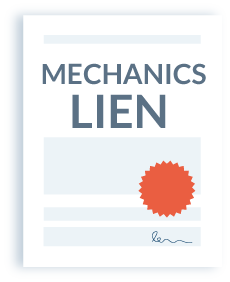
If you’ve been working on a construction project in the state of Rhode Island, and are having payment issues, a mechanics lien might be just the solution you’re looking for. Mechanics lien rights are one of the most effective tools for contractors, subs, and suppliers to protect against nonpayment. This guide will provide you with everything you need to know about how to file a mechanics lien in Rhode Island to ensure you get paid what you’ve earned.
 Do you have the right to file a Rhode Island mechanics lien?
Do you have the right to file a Rhode Island mechanics lien?
Before deciding to file a mechanics lien in Rhode Island, you’ll first need to determine whether or not you even have mechanics lien rights. To find this out, you’ll need to ask yourself two basic questions.
1. Am I covered under the Rhode Island mechanics lien statutes?
Rhode Island law provides lien rights to just about anyone who provides labor or materials to a construction project under an oral or written contract. This includes general contractors, subcontractors, material suppliers, and equipment lessors, of any tier. Architects and engineers also have lien rights as well.
2. Did I need to send a preliminary notice?
Rhode Island doesn’t have a traditional preliminary notice requirement to secure lien rights. But just because they aren’t required doesn’t mean you shouldn’t send one anyway. There are many other benefits to sending a preliminary notice, such as increased visibility and open communication.
However, a Notice of Possible Mechanic’s Lien statement is required by those who contract directly with the owner. A general or prime contractor must either include this statement in their contract or send it by certified mail, with return receipt requested, within 10 days from the commencement of work.
Failing to provide this notice won’t destroy the contractor’s lien rights. But, it will require the contractor to indemnify and hold the owner harmless from any claims by subs and suppliers. Unless of course, it’s because the owner hasn’t paid the GC.
Now that you’ve established if you can file a lien, let’s get into the details.
Step 1: Send a Rhode Island Notice of Intention to Lien
Rhode Island’s mechanics lien process is particularly unique. That’s because the state technically has only one required document, a Notice of Intent to Lien. This acts as a notice of intent and the actual mechanics lien form. Don’t worry, this will all be explained shortly. For now, we’ll start with the form itself.
Download: Customizable Rhode Island Mechanics Lien Form (FREE)
Information to include on the form
It’s time to fill out the notice form. The specific wording and requirements can be found in R.I. Gen. Laws §34-28-4. In this section, we’ll go over all the information you need to provide to get your notice filled out properly.
Owner’s information
First and foremost, you need to provide the owner’s name and information. If there’s more than one owner, provide both. Although the lien attaches to the property, and not the owner; the land evidence records office will need this information for filing purposes. Finding this information can be challenging, especially for lower-tier participants.
For some guidance, learn more about how to find the property owner’s information on a construction project.
Description of the property
The description of the property must be “sufficient to identify it with reasonable certainty.” So this doesn’t have to be a full, legal property description. The statute even states that a street name and number, for example, will be enough.
Labor and/or materials provided & approximate value
This section requires a general description of the work and/or materials provided to the project. You won’t have to provide a full, itemized list of all the work performed, but don’t skimp on the details. Liens are rejected all the time for failing to provide enough information in this section.
In addition to this, you’ll also need to provide an approximate value of the labor and materials provided. This should be a good faith estimation. And, don’t include any attorneys’ fees or collection costs. Claiming too much can potentially result in being liable for filing an exaggerated or fraudulent lien claim.
Hiring party’s information
You should already have this information in hand. Just add the information of the person who you contracted with. This information should be right there in the contract documents themselves. If not, just reach out and ask. If you were hired by the property owner, just repeat their information in this section.
Your information
Although this seems simple, liens have been rejected multiple times for claimants failing to properly identify themselves. This is particularly true if filing on behalf of a company. If so, you need to make sure that you provide the full, legal name of the business. This includes adding the “LLC” or “Co.” to the end of the business name.
Signed & notarized
Now that everything has been filled out properly, it’s time to sign the claim. But wait to sign it until you’re in front of a notary public. Rhode Island lien forms must be notarized in order to be valid.
Deadline to send notice
The Rhode Island Notice of Intent to Lien needs to be sent to the property owner within 200 days from the last date that you furnished labor or materials to the project. It should be sent by certified mail, with return receipt requested. But don’t wait too long to send it. The same 200 day period is the deadline for filing the claim in the recorder’s office.
If the notice is returned “undeliverable”
If your notice was returned as undeliverable, then you’ll need to take an extra step. You’ll need to take the notice, in its envelope, and file it with the land records office of the city or town where the property is located. You must do this within 30 days of its return.
Step 2: File a Rhode Island mechanics lien
Once you’ve served the notice on the property owner, you should give it some time. Which stresses the importance of sending this notice as early as possible. The owner should have ample time to try and resolve the payment dispute before you actually file your claim. But if you are still unpaid, it may be time to file your claim. This may seem like the easy part, but there are a number of different reasons that a lien claim can be rejected.
Some of the more common reasons a mechanics lien is rejected:
- Wrong document formatting
- Improper filing fees
- Filing in the wrong town/city office
- Missing the deadline
Deadline to file a Rhode Island mechanics lien
As mentioned above, the deadline to file a Rhode Island mechanics lien is 200 days from the last date you furnished labor or materials to the project. There is one incredibly important thing to note about RI mechanics liens. The lien claim will only relate back 200 days prior to the date of last furnishing. This means that any labor or materials you provided before that won’t be covered. So on long term projects, you may actually need to file more than one lien.
For example, let’s say you’re working on a 400-day project. If you aren’t paid for your work, you must file your first claim by day 400 – this claim will cover the first 200 days of labor and materials. To cover days 201-400, you will need to file another claim by day 600 at the latest.
Where to file a Rhode Island mechanics lien
Rhode Island mechanics liens must be filed in the records of land evidence office of the town or city where the project is located. Since these are town/city offices, you’ll need to be absolutely sure that you’re filing in the proper office. Also, most offices have their own specific requirements and filing fees. So it’s a good idea to contact the office ahead of time so you know you’ve got everything you need to get your lien filed.
In-person filing
This is the safest option for filing your lien claim. Not only are you actually in the office so you can respond to any errors or mistakes, but it also ensures that your lien gets filed on the same day. If you go this route, you should bring more than one copy if you want a certified copy for your records. Also, more than one blank check is a good idea, just in case you miscalculate the filing fees.
Filing by mail
You can also mail in your lien claim, but this can be a bit risky, particularly if your deadline is coming up. Between the time it takes for the claim to be delivered and get through the backlog, there’s no telling how long it could take. And worse, if the claim is rejected by the town clerk for any reason, it needs to be sent back, corrected and refiled. However, if you do mail in your claim, for record-keeping purposes, you may want to include a self-addressed, stamped envelope with return instructions. That way you can get yourself a certified copy.
What to do after you’ve filed your Rhode Island mechanics lien
If you’ve followed all of these steps, then congratulations! Your Rhode Island mechanics lien claim is filed and ready to work to get you paid. But the journey doesn’t end here. A mechanics lien doesn’t last forever, and you’ll need to take some sort of action after it’s been filed.
Option 1: Enforce (foreclose) the lien claim
The deadline to enforce a Rhode Island mechanics lien is incredibly short, just 40 days from when the lien was filed. Probably because the time to file is so long! If you’re ready to enforce your claim, you’ll need to first file a Notice of Lis Pendens. This can be filed on the same day as the complaint, but the complaint to enforce must be filed in the appropriate superior court within 7 days of the notice. Keep in mind that this is a full lawsuit. You should contact an attorney to help guide you through this process.
Option 2: Release (cancel) the lien claim
If you wind up getting paid, that’s great! Under Rhode Island mechanics lien law, there is no statute that provides any specific responsibilities for the release of lien. However, the way this usually works is that the payment will be conditioned on the release of the claim. This is as simple as filing a document in the same office where the lien is filed stating that the underlying debt has been satisfied.
Rhode Island Construction Lien Law & Payment Resources
- Overview, Forms & FAQs for Mechanics Liens in Rhode Island
- Forms, resources, and guides to help you get paid on Rhode Island construction projects

 Do you have the right to file a Rhode Island mechanics lien?
Do you have the right to file a Rhode Island mechanics lien?

